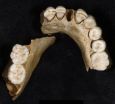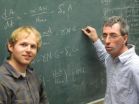(Press-News.org) New findings from an international team of researchers show that most neandertals in Europe died off around 50,000 years ago. The previously held view of a Europe populated by a stable neandertal population for hundreds of thousands of years up until modern humans arrived must therefore be revised.
This new perspective on the neandertals comes from a study of ancient DNA published today in Molecular Biology and Evolution. The results indicate that most neandertals in Europe died off as early as 50,000 years ago. After that, a small group of neandertals recolonised central and western Europe, where they survived for another 10,000 years before modern humans entered the picture. The study is the result of an international project led by Swedish and Spanish researchers in Uppsala, Stockholm and Madrid.
"The fact that neandertals in Europe were nearly extinct, but then recovered, and that all this took place long before they came into contact with modern humans came as a complete surprise to us. This indicates that the neandertals may have been more sensitive to the dramatic climate changes that took place in the last Ice Age than was previously thought", says Love Dalén, associate professor at the Swedish Museum of Natural History in Stockholm.
In connection with work on DNA from neandertal fossils in northern Spain, the researchers noted that the genetic variation among European neandertals was extremely limited during the last ten thousand years before the neandertals disappeared. Older European neandertal fossils, as well as fossils from Asia, had much greater genetic variation, on par with the amount of variation that might be expected from a species that had been abundant in an area for a long period of time.
"The amount of genetic variation in geologically older neandertals as well as in Asian neandertals was just as great as in modern humans as a species, whereas the variation among later European neandertals was not even as high as that of modern humans in Iceland", says Anders Götherström, associate professor at Uppsala University.
The results presented in the study are based entirely on severely degraded DNA, and the analyses have therefore required both advanced laboratory and computational methods. The research team has involved experts from a number of countries, including statisticians, experts on modern DNA sequencing and paleoanthropologists from Denmark, Spain and the US. Only when all members of the international research team had reviewed the findings could they feel certain that the available genetic data actually reveals an important and previously unknown part of neandertal history.
"This type of interdisciplinary study is extremely valuable in advancing research about our evolutionary history. DNA from prehistoric people has led to a number of unexpected findings in recent years, and it will be really exciting to see what further discoveries are made in the coming years", says Juan Luis Arsuaga, professor of human paleontology at the Universidad Complutense of Madrid.
INFORMATION:
CONTACT INFORMATION:
Love Dalén
Associate professor in evolutionary biology
Department of Molecular Systematics
Swedish Museum of Natural History
Stockholm
Mobile: +46 (0)70-777 27 94
E-mail: love.dalen@nrm.se
Anders Götherström
Associate professor in evolutionary genetics
Uppsala University
Mobile: +46 (0)73-992 78 64
E-mail: anders.gotherstrom@ebc.uu.se
Juan-Luis Arsuaga
Centro de Evolución y Comportamiento Humanos (UCM-ISCIII)
Instituto de Salud Carlos III
c/ Monforte de Lemos 5, Pabellón 14
28029 Madrid, Spain
Tel. +34 918222834
jlarsuaga@isciii.es
European Neandertals were on the verge of extinction even before the arrival of modern humans
2012-02-27
ELSE PRESS RELEASES FROM THIS DATE:
Mass. General researchers isolate egg-producing stem cells from adult human ovaries
2012-02-27
For the first time, Massachusetts General Hospital (MGH) researchers have isolated egg-producing stem cells from the ovaries of reproductive age women and shown these cells can produce what appear to be normal egg cells or oocytes. In the March issue of Nature Medicine, the team from the Vincent Center for Reproductive Biology at MGH reports the latest follow-up study to their now-landmark 2004 Nature paper that first suggested female mammals continue producing egg cells into adulthood.
"The primary objective of the current study was to prove that oocyte-producing stem ...
Call for tough new targets on European Union energy reduction
2012-02-27
Energy efficiency experts at the University of East Anglia (UEA) are calling for ambitious new targets to reduce energy demand across the European Union.
In a report published today by the Build with CaRe consortium, the researchers propose a new EU target of a 40 per cent reduction in primary energy demand by 2050. The existing target is a 20 per cent improvement in energy efficiency by 2020, but the EU is currently on track to achieve only half of this.
The report by Dr Bruce Tofield and Martin Ingham, associate consultants at UEA's Adapt Low Carbon Group concludes ...
Elusive platelet count and limb development gene discovered
2012-02-27
Researchers have identified an elusive gene responsible for Thrombocytopenia with Absent Radii (TAR), a rare inherited blood and skeletal disorder. As a result, this research is now being transformed into a medical test that allows prenatal diagnosis and genetic counselling in affected families.
The team used genetic sequencing to discover that TAR results from low levels of the protein called Y14. They found that the syndrome occurs by a unique inherited mechanism.
Platelets are the second most abundant cell in the blood. Their main task is to survey the blood vessel ...
Ancient Arabic writings help scientists piece together past climate
2012-02-27
Ancient manuscripts written by Arabic scholars can provide valuable meteorological information to help modern scientists reconstruct the climate of the past, a new study has revealed. The research, published in Weather, analyses the writings of scholars, historians and diarists in Iraq during the Islamic Golden Age between 816-1009 AD for evidence of abnormal weather patterns.
Reconstructing climates from the past provides historical comparison to modern weather events and valuable context for climate change. In the natural world trees, ice cores and coral provide evidence ...
Dental pulp stem cells transformed by 'bad breath' chemical
2012-02-27
Japanese scientists have found that the odorous compound responsible for halitosis – otherwise known as bad breath – is ideal for harvesting stem cells taken from human dental pulp.
In a study published today, Monday 27 February, in IOP Publishing's Journal of Breath Research, researchers showed that hydrogen sulphide (H2S) increased the ability of adult stem cells to differentiate into hepatic (liver) cells, furthering their reputation as a reliable source for future liver-cell therapy.
This is the first time that liver cells have been produced from human dental ...
Volcanoes deliver 2 flavors of water
2012-02-27
Washington, D.C.— Seawater circulation pumps hydrogen and boron into the oceanic plates that make up the seafloor, and some of this seawater remains trapped as the plates descend into the mantle at areas called subduction zones. By analyzing samples of submarine volcanic glass near one of these areas, scientists found unexpected changes in isotopes of hydrogen and boron from the deep mantle. They expected to see the isotope "fingerprint" of seawater. But in volcanoes from the Manus Basin they also discovered evidence of seawater distilled long ago from a more ancient plate ...
In vino veritas: Promiscuous yeast hook up in wine-making vats, Stanford study shows
2012-02-27
STANFORD, Calif. — Humans aren't the only species that like to get busy with a glass of bubbly, according to researchers at the Stanford University School of Medicine. Turns out, the common baker's yeast has indulged in a frenzy of amorous frolicking in the fermentation vats of winemakers for hundreds, possibly thousands, of years, with interesting results.
The unexpected promiscuity has made the lineage of many commercial and wild yeast strains difficult to trace. But there are also indications that such willy-nilly sharing of genetic information is precisely what gives ...
How to rescue the immune system
2012-02-27
MAYWOOD, Ill. – In a study published in Nature Medicine, Loyola researchers report on a promising new technique that potentially could turn immune system killer T cells into more effective weapons against infections and possibly cancer.
The technique involves delivering DNA into the immune system's instructor cells. The DNA directs these cells to overproduce a specific protein that jumpstarts important killer T cells. These killer cells are typically repressed in patients who have HIV or cancer, said José A. Guevara-Patino, MD, PhD, senior author of the study. Guevara ...
Scientists score 1 more victory over uncertainty in quantum physics measurements
2012-02-27
Most people attempt to reduce the little uncertainties of life by carrying umbrellas on cloudy days, purchasing automobile insurance or hiring inspectors to evaluate homes they might consider purchasing. For scientists, reducing uncertainty is a no less important goal, though in the weird realm of quantum physics, the term has a more specific meaning.
For scientists working in quantum physics, the Heisenberg Uncertainty Principle says that measurements of properties such as the momentum of an object and its exact position cannot be simultaneously specified with arbitrary ...
Math can save Tylenol overdose patients
2012-02-27
SALT LAKE CITY, Feb. 27, 2012 – University of Utah mathematicians developed a set of calculus equations to make it easier for doctors to save Tylenol overdose patients by quickly estimating how much painkiller they took, when they consumed it and whether they will require a liver transplant to survive.
"It's an opportunity to use mathematical methods to improve medical practice and save lives," says Fred Adler, a professor of mathematics and biology and coauthor of a study that developed and tested the new method.
The study of acetaminophen – the generic pain and ...

